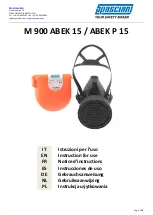
Manual
8
Non-Newtonian fluids:
In these liquids there is no linear relationship between the shear stress and the shear rate. Therefore,
differing viscosity values will be obtained under different environmental and operating conditions. The
apparent viscosity of the liquid must be established by a fluid analysis. This result cannot be reproduced
by using a different viscometer, unless the environmental and operating conditions are identical, and the
analysis is carried out following a defined working process. The variables below influence the results:
Viscometer model
Dimension of the sample container
Filling level
Sample temperature
Spindle
Rotational speed
Whether or not a spindle protector is being used
Duration of the test (time dependant fluids)
Invariably, any change in the working methods will lead to a change in results.
Non-Newtonian liquids can have a variety of properties:
Pseudoplastic:
A fluid the viscosity of which decreases with an increase in the shear rate is called pseudoplastic. This
flow behaviour is also call
ed “shearthinning”. Some examples of pseudoplastic fluids are: coatings, milk,
ink or jam.
Plastic:
Under static conditions, these fluids appear to be solid. In order to carry out an analysis of these fluids, it
is necessary for them to be subjected to a yield stress, so that they show characteristics similar to
pseudoplastic or dilatant fluids. Examples: toothpaste, chocolate or grease.
Dilatant:
A fluid the viscosity of which increases with an increase in the shear rate (shear-thickening flow
behaviour). Example: Solution of sugar and water or mixture of sand and water.
Time-dependent fluids:
A fluid the viscosity of which changes not only due to the shear rate, but also as a result of the time lapse
since the shear process was started is called a time-dependent fluid.
Thixotropic fluids:
In thixotropic fluids, the viscosity decreases when the shear stress increases over time, e. g. when the
fluid is stirred at a constant shear rate. The viscosity will increase when the shear stress ends.
Examples: ketchup, honey, non-drip paint, mayonnaise.
Rheopectic fluids:
Fluids the viscosity of which increases with increasing shear stress at a constant shear rate are called
rheopectic fluids.
Examples: lubricants, special types of paint.
6.3
Spindles
The spindles are made with high precision to ensure maximum repeatability of test results, as long as the
measuring instrument is used under the correct operating conditions.
Содержание PCE-RVI 2
Страница 4: ...Manual 4 4 System description...
Страница 5: ...Manual 5...
Страница 28: ...BETRIEBSANLEITUNG 4 4 Systembeschreibung 4 1 Vorderansicht...
Страница 29: ...BETRIEBSANLEITUNG 5 4 2 R ckansicht...









































